Regular Wave Effects on the Hydrodynamic Performance of Fine-Mesh Nettings in Sampling Nets
Abstract
1. Introduction
2. Material and Methods
2.1. Hydrodynamic Experiment of Fine-Mesh Nettings in a Wave Tank
2.1.1. Netting Models and Hydrodynamic Experimental Setup
2.1.2. Wave Condition
2.1.3. Determination of the Hydrodynamic Coefficients
2.2. PIV Measurement Experiment for Field Distribution Around the Netting
2.3. Numerical Simulation of the Netting Models
2.3.1. Governing Equations
2.3.2. Porous Media Model
2.4. Numerical Wave Tank
2.4.1. Wave Generation
2.4.2. Wave Absorption
2.4.3. Boundary Conditions and Solution Algorithm for the Numerical Wave Tank
2.4.4. Validation of the Numerical Wave Tank
3. Results
3.1. Hydrodynamic Force on Fine-Mesh Nettings in Waves
3.2. Hydrodynamic Coefficients of Fine-Mesh Nettings in Waves
3.3. Wave Attenuation Downstream of Fine-Mesh Nettings Under Different Wave Conditions
3.4. Water Particle Velocity Field Distribution of the Fine-Mesh Nettings
4. Discussion
5. Conclusions
- (1)
- The horizontal wave forces increased with both the wave period and wave height for all nettings. The maximum experimental and numerical peak values of the wave force were 28.12 N and 27.47 N for Net 1, and 15.66 N and 14.90 N for Net 2, respectively, at a wave height of 0.19 m and a wave period of 2.3 s.
- (2)
- When the wave period was held constant, the drag and inertial coefficients for both nettings generally decreased with increasing Reynolds and KC numbers. The maximum drag and inertial coefficients for Net 1 were 2.52 and 0.45, respectively, and for Net 2, 1.74 and 0.58, respectively, at a wave period of 2.3 s and a wave height of 0.1 m.
- (3)
- The wave transmission coefficients of the nettings decreased with an increasing wave height at constant wave periods. However, the coefficients increased initially and then decreased as the wave period increased at constant wave heights. As waves propagate through the netting, both the wave crest and trough are diminished due to the damping effect of the netting. Additionally, the downstream wave amplitude attenuation was smaller for Net 2 than for Net 1 due to the smaller solidity ratio of Net 2.
- (4)
- The water particle velocity was significantly affected by the presence of the nettings, with the downstream velocity decreasing notably at both the wave crest and wave trough. The simulation and PIV measurement results for the water particle velocity field distribution were in good agreement.
Author Contributions
Funding
Institutional Review Board Statement
Informed Consent Statement
Data Availability Statement
Conflicts of Interest
References
- Sameoto, D.D.; Jaroszynski, L.O.; Fraser, W.B. Bioness, a new design in multiple net zooplankton samplers. Can. J. Fish. Aquat. Sci. 1980, 37, 722–724. [Google Scholar] [CrossRef]
- Dimmler, W.; Klindt, H. A new electronic system for the rectangular midwater trawl (RMT). Mar. Biol. 1990, 107, 345–348. [Google Scholar] [CrossRef]
- Dunn, J.; Mitchell, R.B.; Urquhart, G.G.; Ritchie, B.J. LOCHNESS-a new multi-net midwater sampler. ICES J. Mar. Sci. 1993, 50, 203–212. [Google Scholar] [CrossRef]
- Baker, A.d.C.; Clarker, M.R.; Harris, M.J. The N.I.O. combination net (RMT 1+8) and further developments of rectangular midwater trawls. J. Mar. Biol. Assoc. UK 1973, 53, 167–184. [Google Scholar] [CrossRef]
- Engås, A.; Skeide, R.; West, C.W. The ‘MultiSampler’: A system for remotely opening and closing multiple codends on a sampling trawl. Fish. Res. 1997, 29, 295–298. [Google Scholar] [CrossRef]
- Methot, R.D. Frame trawl for sampling pelagic juvenile fish. Calcofi. Rep. 1986, 27, 267–278. [Google Scholar]
- Kristiansen, T.; Faltinsen, O.M. Modelling of current loads on aquaculture net cages. J. Fluid Struct. 2012, 34, 218–235. [Google Scholar] [CrossRef]
- Klebert, P.; Lader, P.; Gansel, L.; Oppedal, F. Hydrodynamic interactions on net panel and aquaculture fish cages: A review. Ocean Eng. 2013, 58, 260–274. [Google Scholar] [CrossRef]
- Imai, T. Basic studies on the plane net set into the flowing water-IV. Comparative study of hydrodynamic resistance on knotted and knotless nettings. Bull. Jap. Soc. Sci. Fish. 1979, 45, 1277–1282. [Google Scholar] [CrossRef]
- Moe-Føre, H.; Endresen, P.C.; Norvik, C.; Lader, P. Hydrodynamic loads on net panels with different solidities. J. Offshore Mech. Arctic Eng. 2021, 143, 051901. [Google Scholar] [CrossRef]
- Wang, G.; Martin, T.; Huang, L.Y.; Bihs, H. An improved screen force model based on CFD simulations of the hydrodynamic loads on knotless net panels. Appl. Ocean Res. 2022, 118, 102965. [Google Scholar] [CrossRef]
- Nonoda, T. On the resistance of plane minnow netting. Bull. Japan. Soc. Sci. Fish. 1969, 35, 1151–1156. [Google Scholar] [CrossRef]
- Gjøsund, S.H.; Enerhaug, B. Flow through nets and trawls of low porosity. Ocean Eng. 2010, 37, 345–354. [Google Scholar] [CrossRef]
- Kumazawa, T.; Hu, F.X.; Kinoshita, H.; Tokai, T. Hydrodynamic characteristics of plane minnow netting made of high strength polyethylene (Dyneema). Nippon Suisan Gakk. 2012, 78, 180–188. [Google Scholar] [CrossRef]
- Shimizu, H.; Mizukami, Y.; Kitazawa, D. Experimental study of the drag on fine-mesh netting. Aqua. Eng. 2018, 81, 101–106. [Google Scholar] [CrossRef]
- Gjøsund, S.H. Simplified approximate expressions for the boundary layer flow in cylindrical sections in plankton nets and trawls. Open J. Mar. Sci. 2012, 2, 66–69. [Google Scholar] [CrossRef]
- Liu, Z.Q.; Hu, F.X.; Wan, R.; Zhang, T.Z.; Wang, Y.C.; Guo, S.J.; Zhou, C. Evaluating the hydrodynamic characteristics and shape configuration of fine-mesh nettings for sampling nets. Ocean Eng. 2024, 312, 119143. [Google Scholar] [CrossRef]
- Breddermann, K. Filtration Performance of Plankton Nets Used to Catch Micro- and Mesozooplankton; Rostocker Meerestechnische Reihe; Shaker Verlag GmbH: Düren, Germany, 2017; Volume 12, ISBN 103844054057. [Google Scholar]
- Grimaldo, E.; Herrmann, B.; Kostak, E.; Brinkhof, J. Understanding the effect of design parameters on the filtration efficiency of trawls intended for commercial harvesting of zooplankton. Ocean Eng. 2023, 288, 116141. [Google Scholar] [CrossRef]
- Takagi, T.; Suzuki, K.; Hiraishi, T. Modeling of net for calculation method of dynamic fishing net shape. Fish. Sci. 2002, 68, 1857–1860. [Google Scholar] [CrossRef][Green Version]
- Tang, M.F.; Dong, G.H.; Xu, T.J.; Zhao, Y.P.; Bi, C.W.; Guo, W.J. Experimental analysis of the hydrodynamic coefficients of net panels in current. Appl. Ocean Res. 2018, 79, 253–261. [Google Scholar] [CrossRef]
- Song, W.H.; Liang, Z.L.; Cui, H.F.; Huang, L.Y.; Zhao, F.F.; Zhu, L.X.; Chen, B.H. Experimental study on the effect of horizontal waves on netting panels. Fish. Sci. 2006, 72, 967–976. [Google Scholar] [CrossRef]
- Lader, P.F.; Olsen, A.; Jensen, A.; Sveen, J.K.; Fredheim, A.; Enerhaug, B. Experimental investigation of the interaction between waves and net structures-Damping mechanism. Aqua. Eng. 2007, 37, 100–114. [Google Scholar] [CrossRef]
- Lader, P.F.; Jensen, A.; Sveen, J.K.; Fredheim, A.; Enerhaug, B.; Fredriksson, D. Experimental investigation of wave forces on net structures. Appl. Ocean Res. 2007, 29, 112–127. [Google Scholar] [CrossRef]
- Zhao, Y.P.; Li, Y.C.; Dong, G.H.; Gui, F.K.; Wu, H. An experimental and numerical study of hydrodynamic characteristics of submerged flexible plane nets in waves. Aqua. Eng. 2008, 38, 16–25. [Google Scholar] [CrossRef]
- Liu, L.L.; Kinoshita, T.; Wan, R.; Bao, W.G.; Itakura, H. Experimental investigation and analysis of hydrodynamic characteristics of a net panel oscillating in water. Ocean Eng. 2012, 47, 19–29. [Google Scholar] [CrossRef]
- Bi, C.W.; Zhao, Y.P.; Dong, G.H.; Cui, Y.; Gui, F.K. Experimental and numerical investigation on the damping effect of net cages in waves. J. Fluids Struct. 2015, 55, 122–138. [Google Scholar] [CrossRef]
- Bi, C.W.; Chen, Q.P.; Zhao, Y.P.; Su, H.; Wang, X.Y. Experimental investigation on the hydrodynamic performance of plane nets fouled by hydroids in waves. Ocean Eng. 2020, 213, 107839. [Google Scholar] [CrossRef]
- Dong, G.H.; Tang, M.F.; Xu, T.J.; Bi, C.W.; Guo, W.J. Experimental analysis of the hydrodynamic force on the net panel in wave. Appl. Ocean Res. 2019, 87, 233–246. [Google Scholar] [CrossRef]
- Xu, T.J.; Dong, G.H.; Tang, M.F.; Liu, J.; Guo, J.W. Experimental analysis of hydrodynamic forces on net panel in extreme waves. Appl. Ocean Res. 2021, 107, 102495. [Google Scholar] [CrossRef]
- Zhang, Y.M.; Bi, C.W.; Feng, L.; Huang, L.Y. Hydrodynamic response analysis of the aquaculture net under the combined action of irregular waves and currents. Ships Offsh Struct. 2024, 19, 1–17. [Google Scholar] [CrossRef]
- Dong, S.C.; You, X.X.; Hu, F.X. Effects of wave forces on knotless polyethylene and chain-link wire netting panels for marine aquaculture cages. Ocean Eng. 2020, 207, 107368. [Google Scholar] [CrossRef]
- Bi, C.W.; Zhao, Y.P.; Dong, G.H.; Xu, T.J.; Gui, F.K. Numerical study on wave attenuation inside and around a square array of biofouled net cages. Aqua. Eng. 2017, 78, 180–189. [Google Scholar] [CrossRef]
- Tsukrov, I.; Eroshkin, O.; Fredriksson, D.; Swift, M.R.; Celikkol, B. Finite element modeling of net panels using a consistent net element. Ocean Eng. 2003, 30, 251–270. [Google Scholar] [CrossRef]
- Li, Y.C.; Zhao, Y.P.; Gui, F.K.; Teng, B. Numerical simulation of the hydrodynamic behavior of submerged plane nets in current. Ocean Eng. 2006, 33, 2352–2368. [Google Scholar] [CrossRef]
- Lee, C.W.; Kim, Y.B.; Lee, G.H.; Choe, M.Y.; Lee, M.K.; Koo, K.Y. Dynamic simulation of a fish cage system subjected to currents and waves. Ocean Eng. 2008, 35, 1521–1532. [Google Scholar] [CrossRef]
- Chen, H.; Christensen, E.D. Development of a numerical model for fluid-structure interaction analysis of flow through and around an aquaculture net cage. Ocean Eng. 2017, 142, 597–615. [Google Scholar] [CrossRef]
- Zhao, Y.P.; Bi, C.W.; Liu, Y.X.; Dong, G.H.; Gui, F.K. Numerical simulation of interaction between waves and net panel using porous media model. Eng. Appl. Comput. Fluid Mech. 2014, 8, 116–126. [Google Scholar] [CrossRef]
- Chen, H.; Christensen, E.D. Numerical simulation of wave interaction with moving net structures. In Proceedings of the ASME 2015 34th International Conference on Ocean, Offshore and Arctic Engineering, St. John’s, NL, Canada, 31 May–5 June 2015. [Google Scholar] [CrossRef]
- Dean, R.G.; Dalrymple, R.A. Water Wave Mechanics for Engineers and Science; World Scientific Publishing: Singapore, 1991. [Google Scholar] [CrossRef]
- Sriram, V.; Schlurmann, T.; Schimmels, S. Focused wave evolution using linear and second order wavemaker theory. Appl. Ocean Res. 2015, 53, 279–296. [Google Scholar] [CrossRef]
- Bi, C.W.; Zhao, Y.P.; Dong, G.H. Experimental investigation of the reduction in flow velocity downstream from a fishing net. Aqua. Eng. 2013, 57, 71–81. [Google Scholar] [CrossRef]
- Bouhoubeiny, E.; Germain, G.; Druault, P. Time-resolved PIV investigations of the flow field around cod-end net structures. Fish. Res. 2011, 108, 344–355. [Google Scholar] [CrossRef]
- Wang, B.; Wang, X.L.; Gao, S.; Qiao, D.S.; Li, Y.; Deng, Z.R.; Ou, J.P. Numerical simulation of hydrodynamic forces acting on curved shape trash intercepting net in nuclear power plant under regular waves. China Ocean. Eng. 2024. [Google Scholar] [CrossRef]
- Yadav, S.S.; DebRoy, P. Generation of stable linear waves in shallow water in a numerical wave tank. J. Appl. Fluid Mech. 2022, 15, 537–549. [Google Scholar] [CrossRef]
- Druault, P.; Germain, G.; Facq, J.V. PIV measurements combined with the motion tracking technique to analyze flow around a moving porous structure. J. Fluids Struct. 2015, 56, 190–204. [Google Scholar] [CrossRef]
- Druault, P.; Germain, G. Analysis of hydrodynamics of a moving trawl codend and its fluttering motions in flume tank. Eur. J. Mech. B/Fluids. 2016, 60, 219–229. [Google Scholar] [CrossRef]
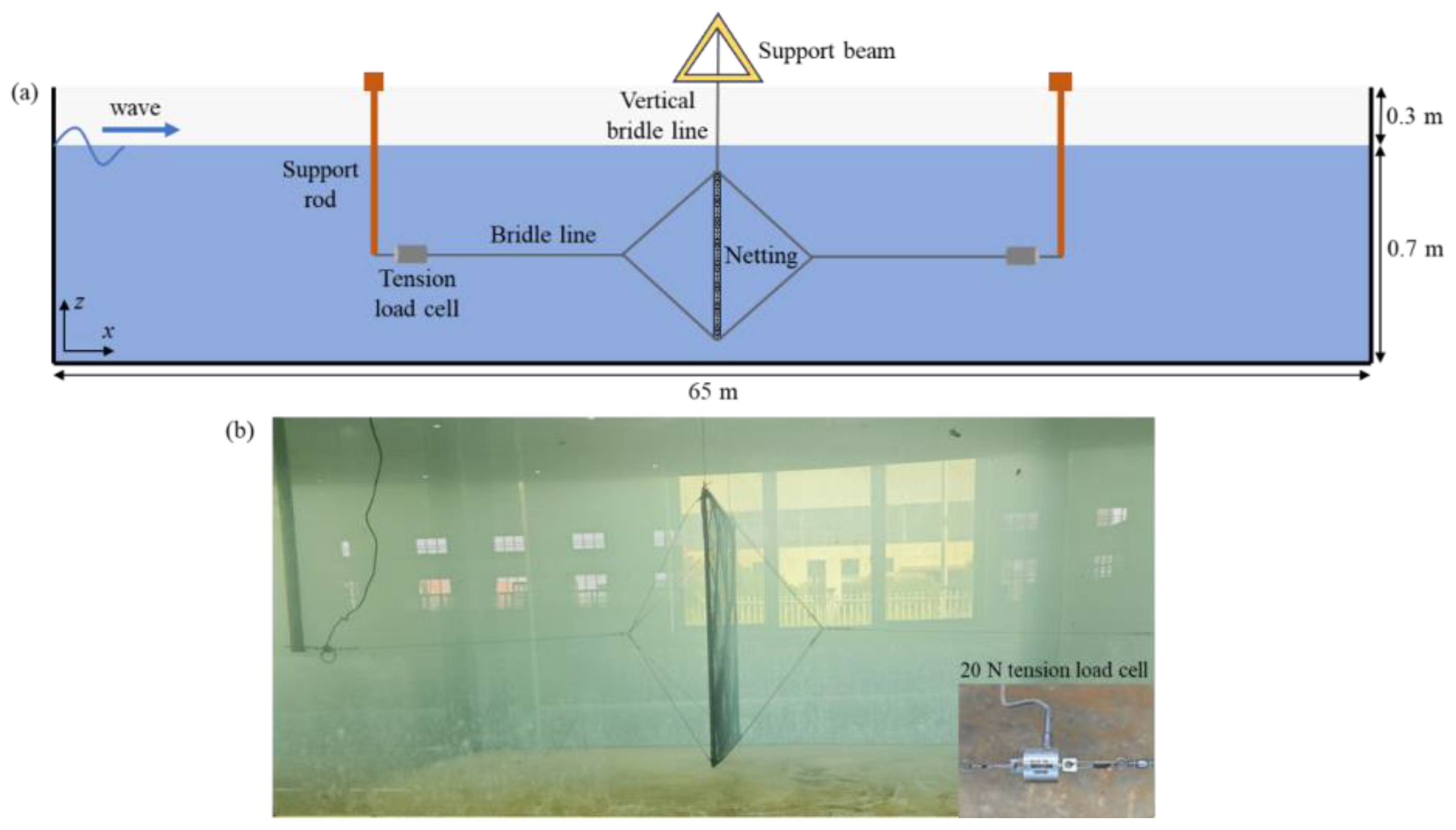
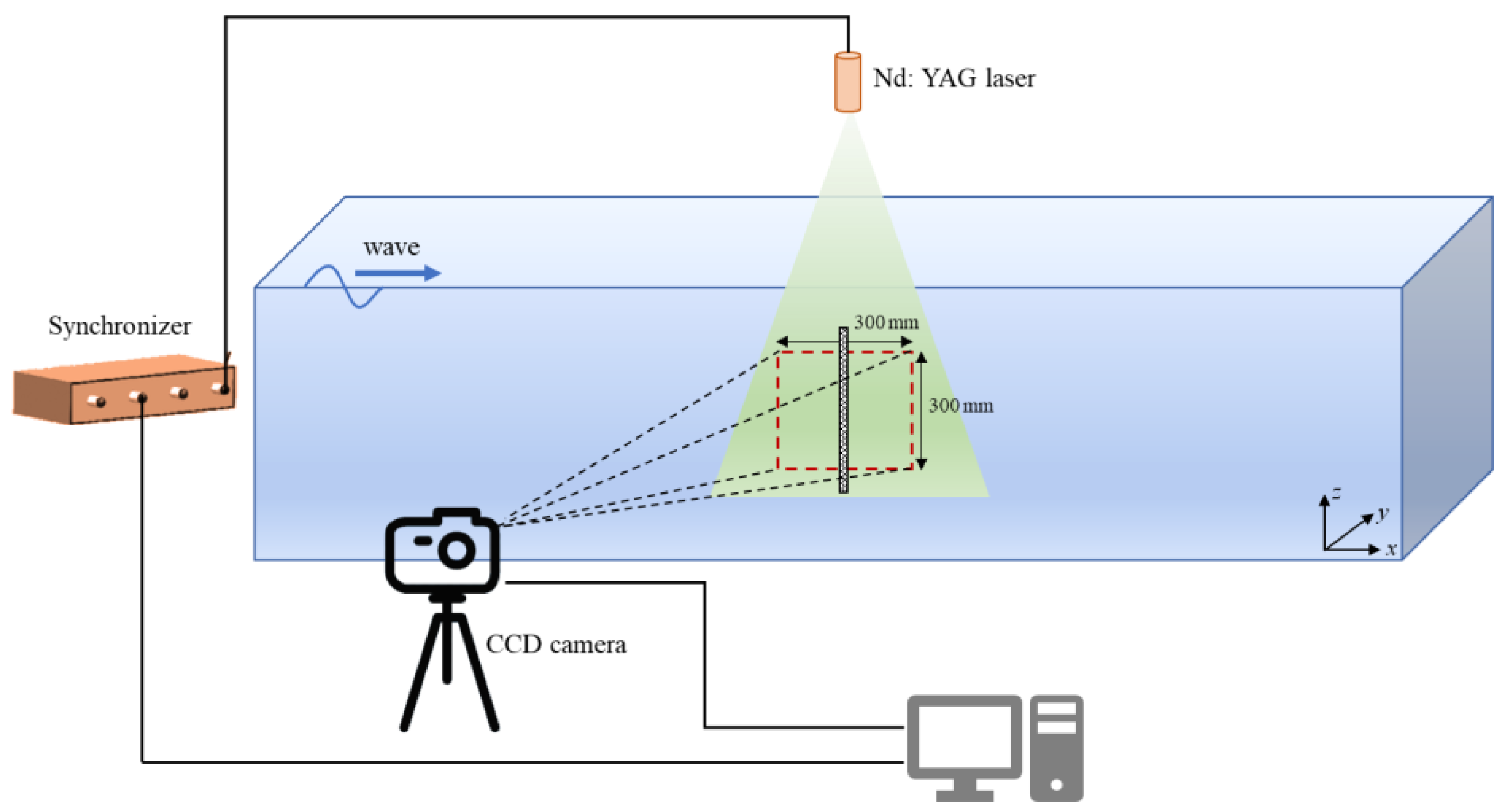
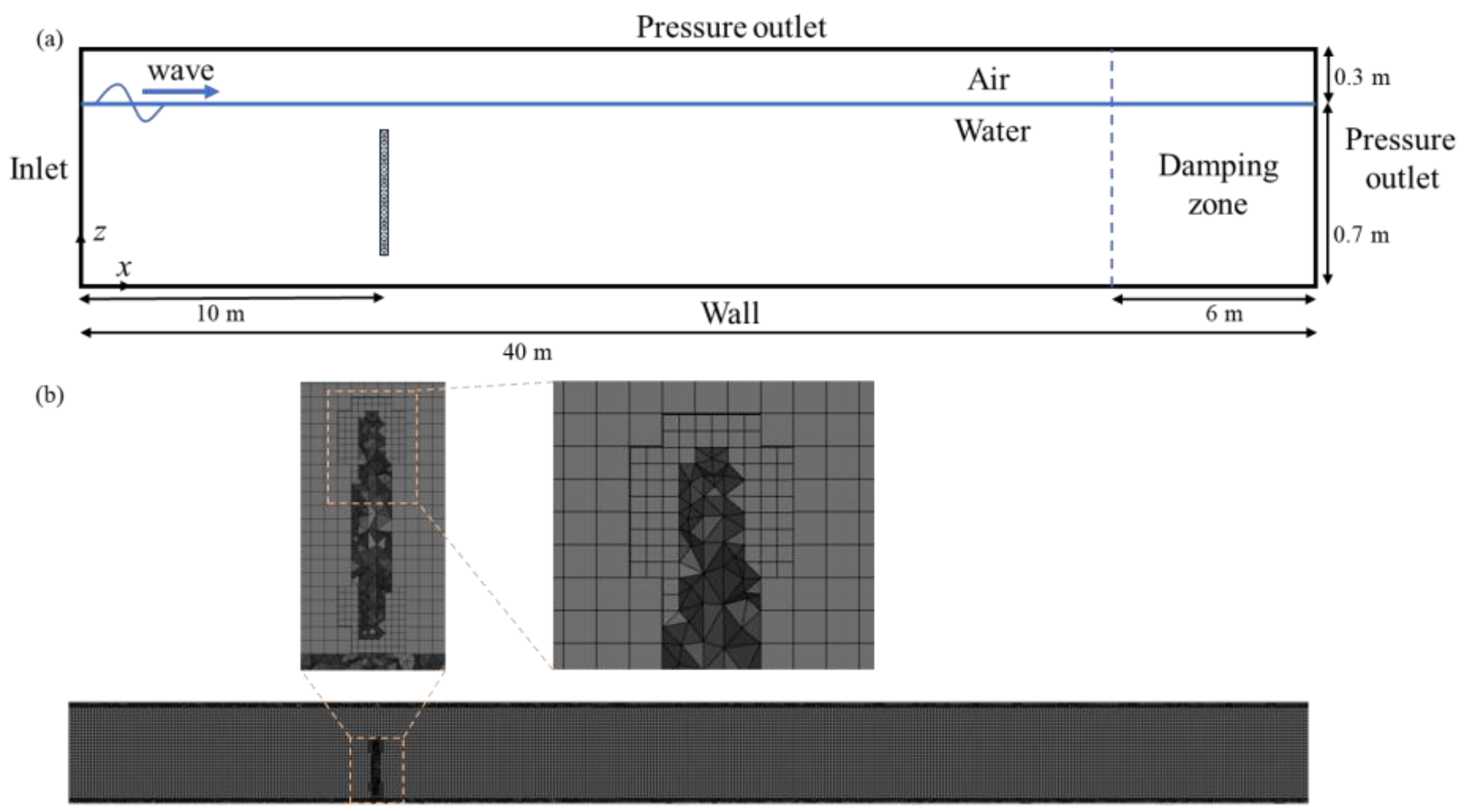
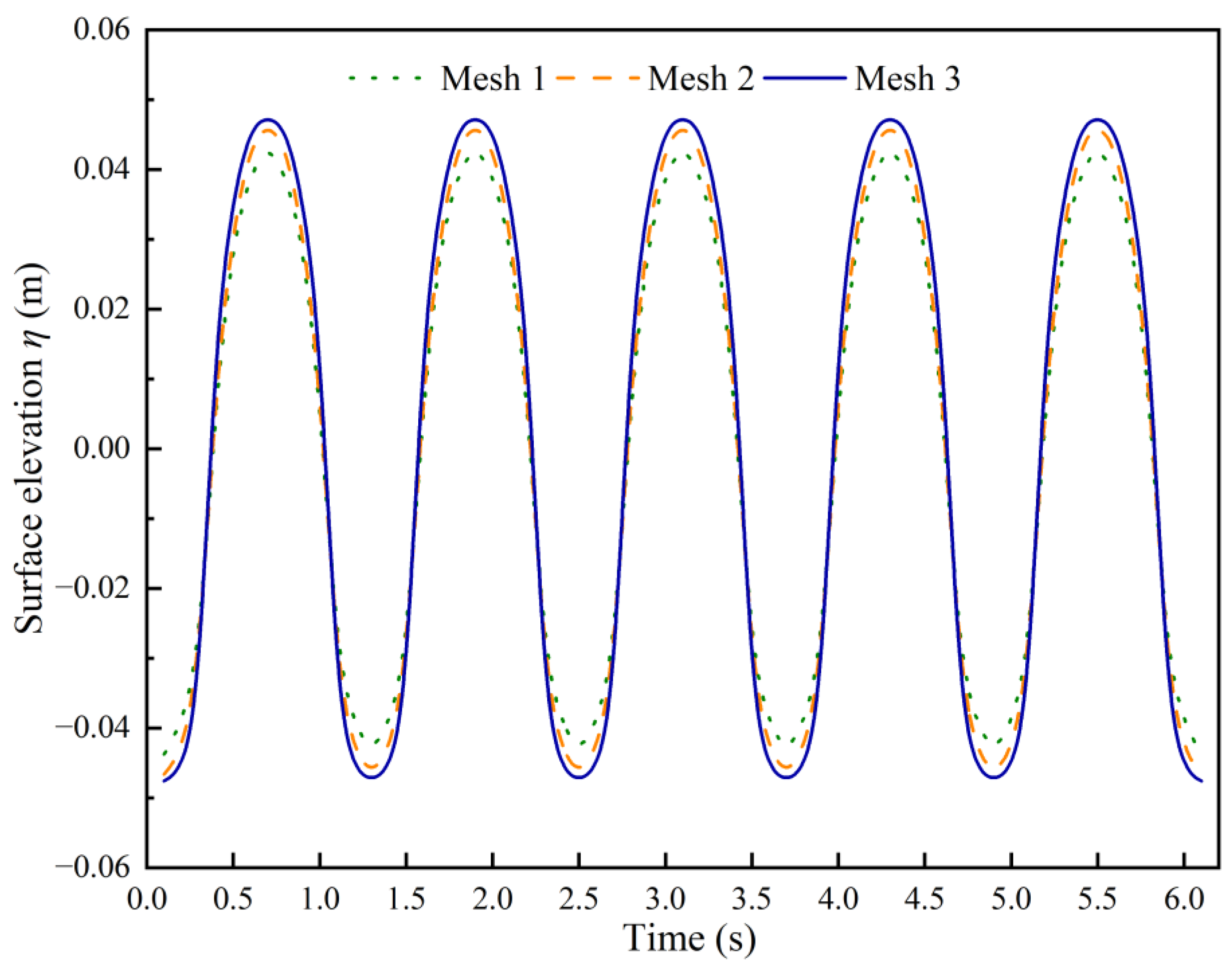
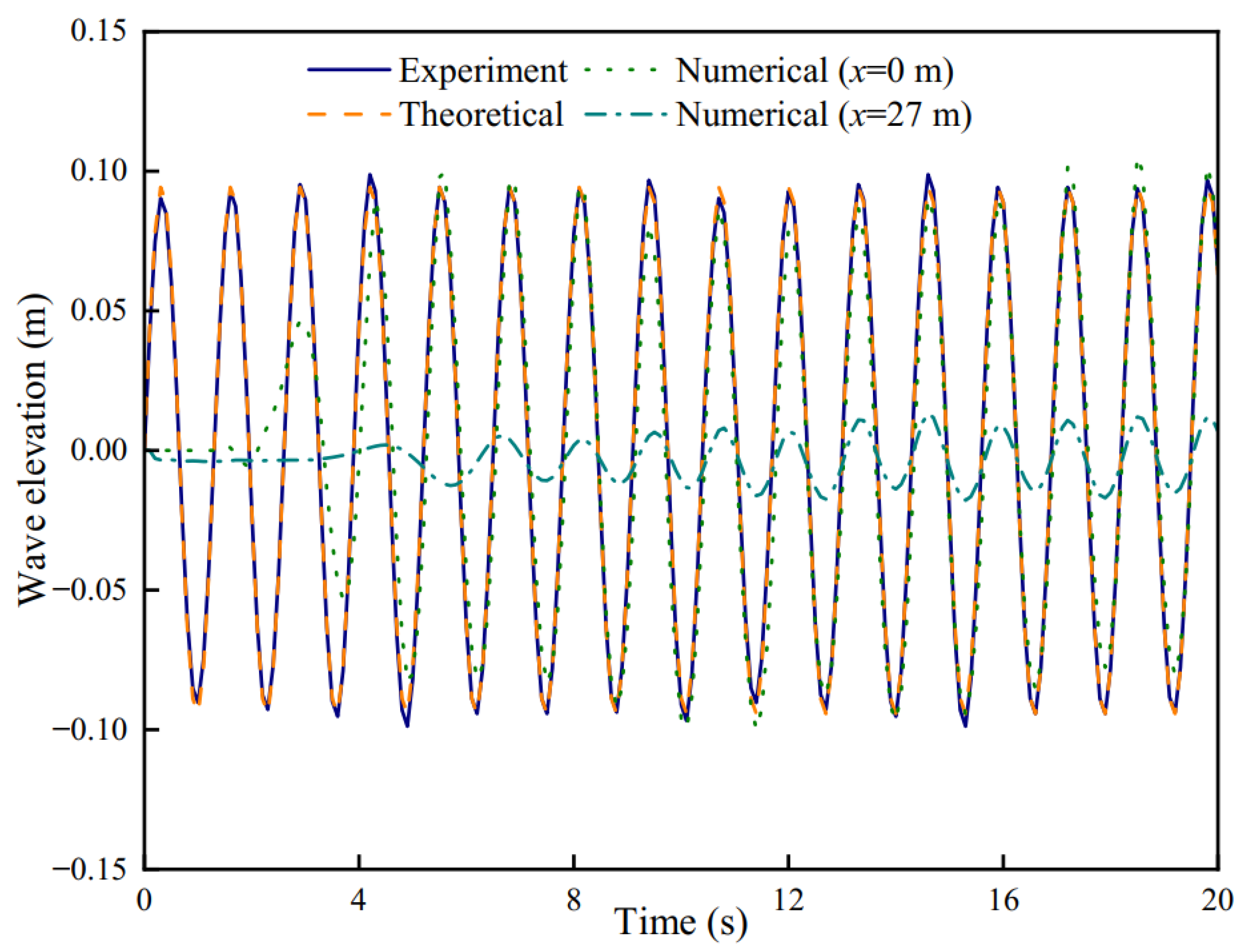
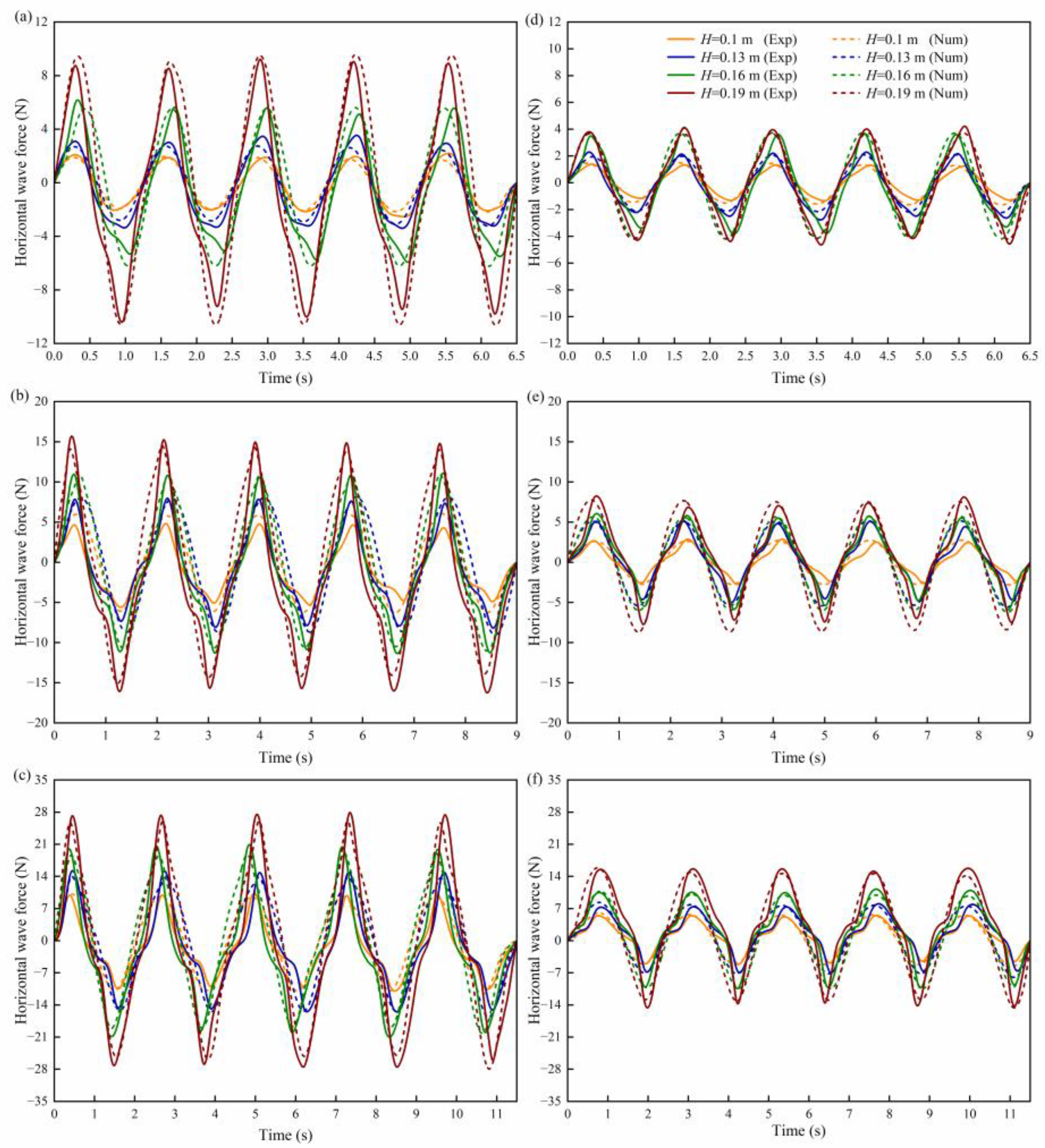
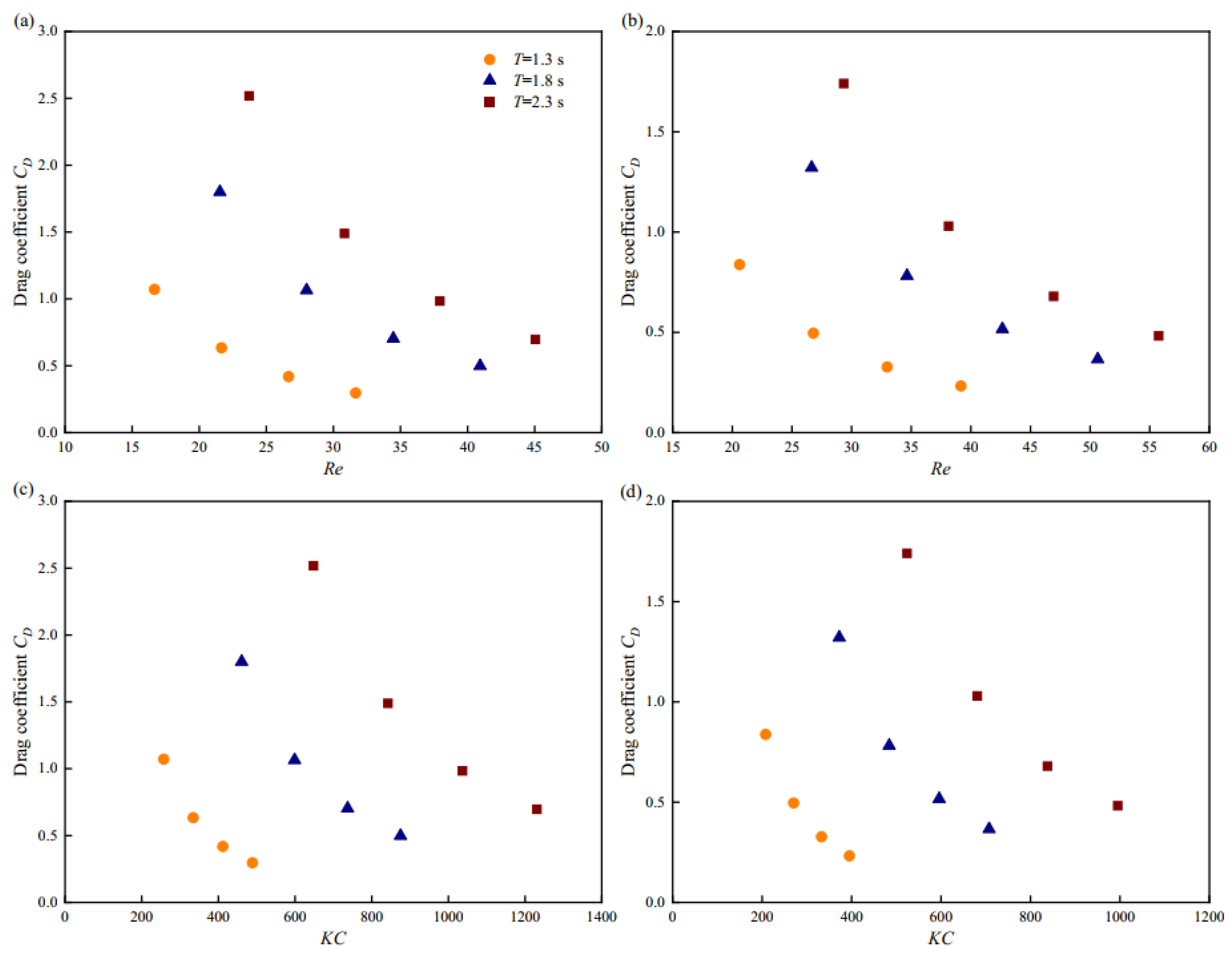
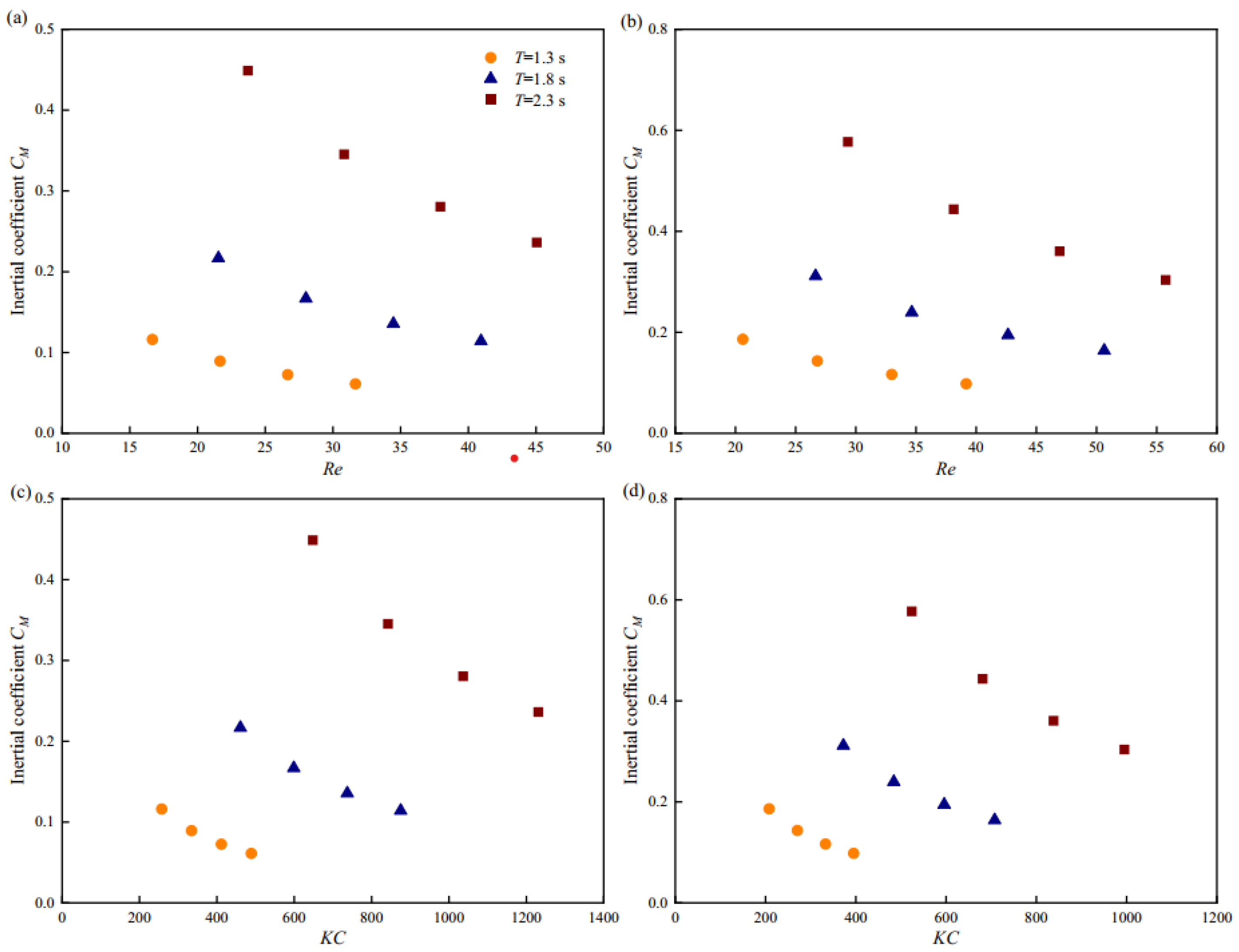
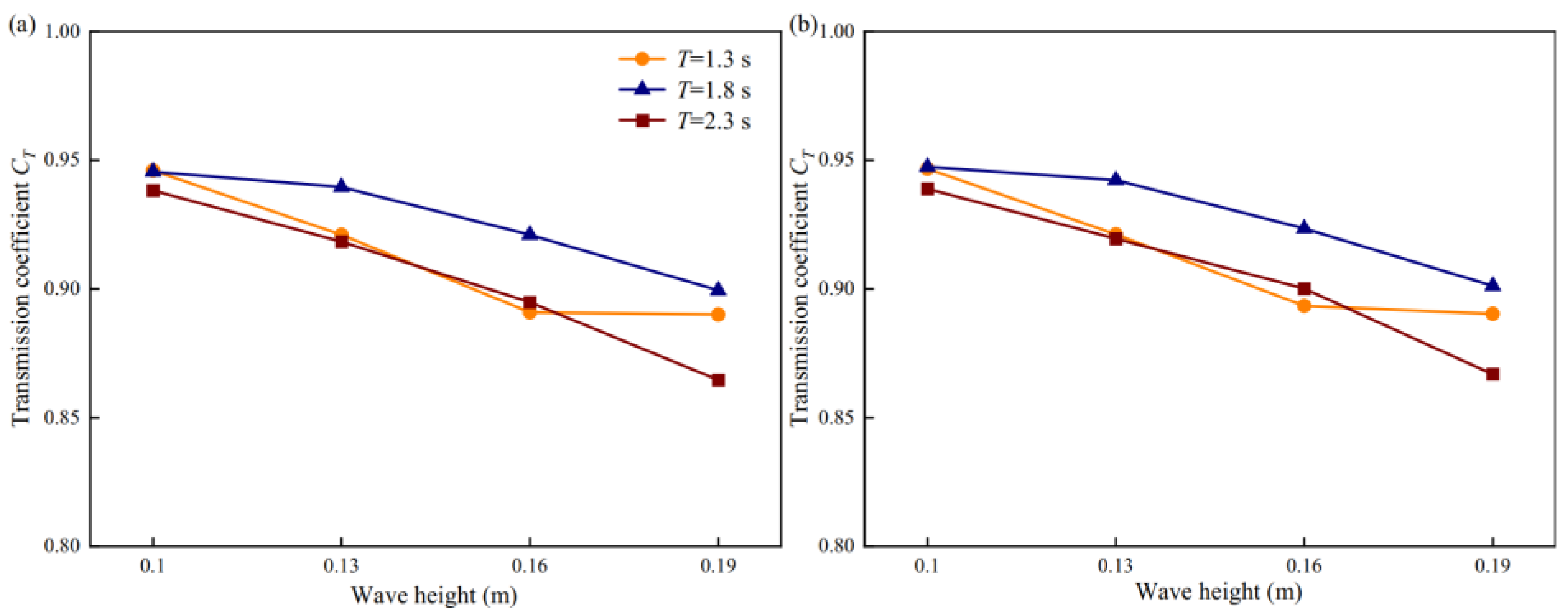

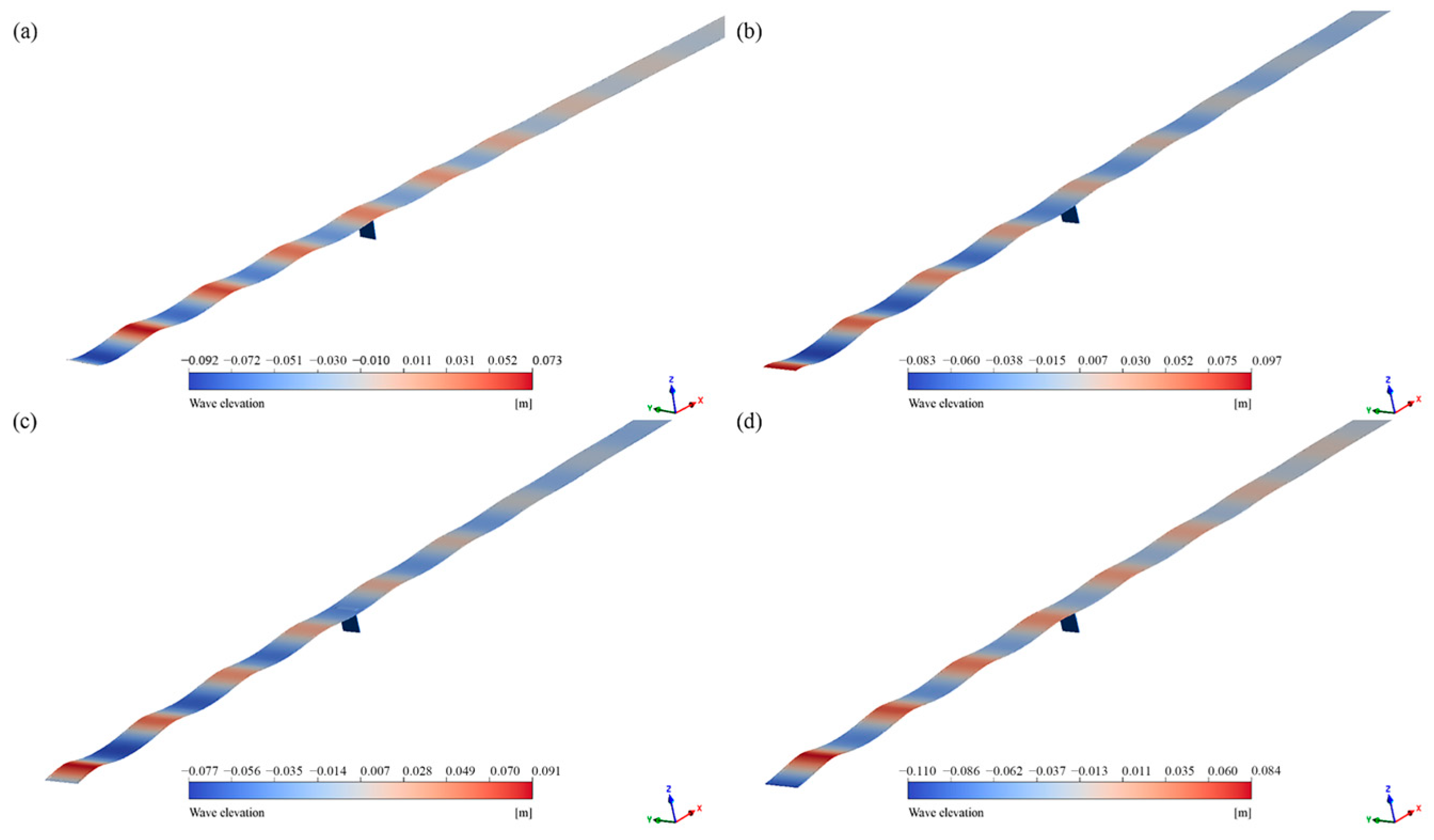
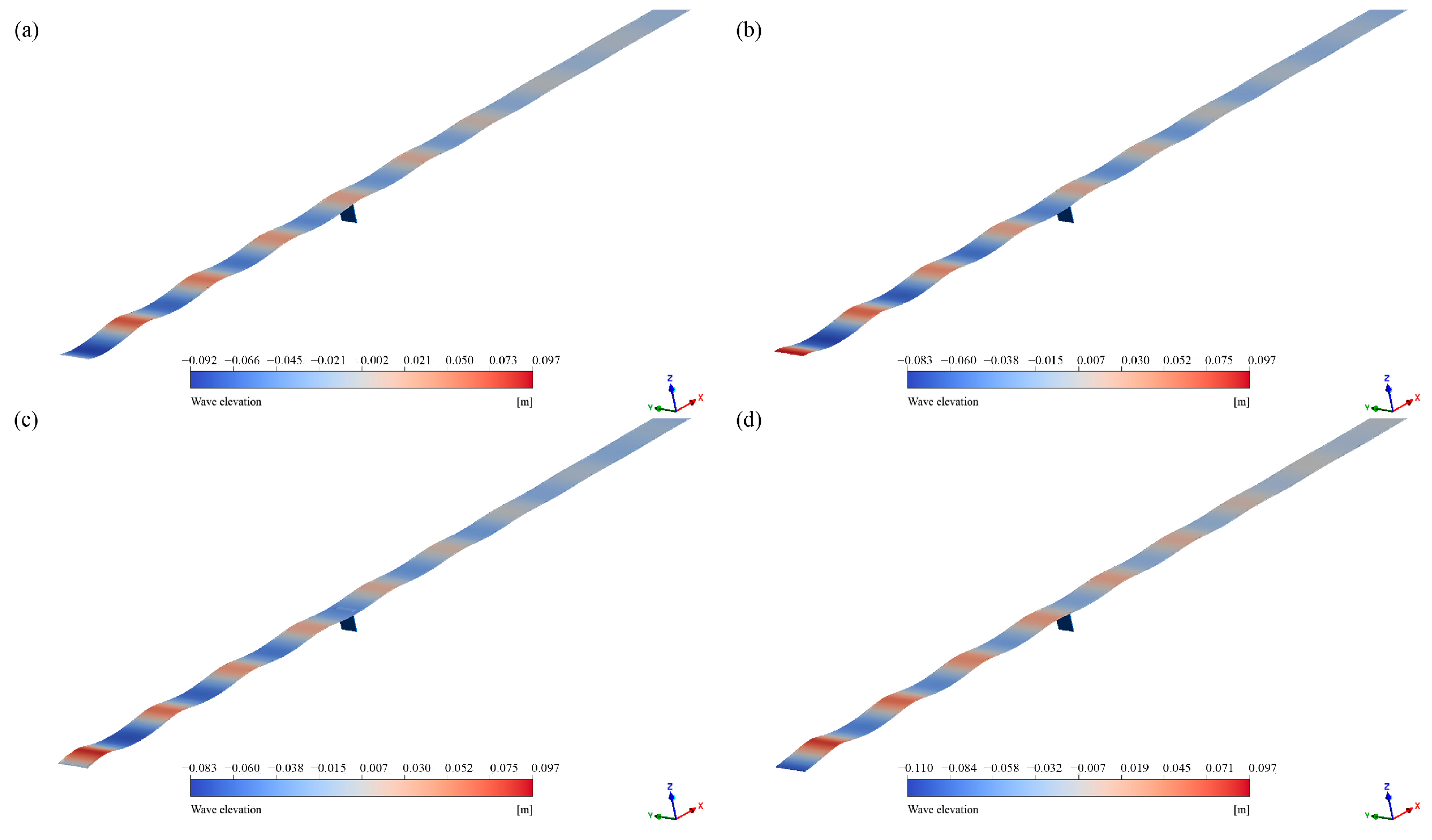
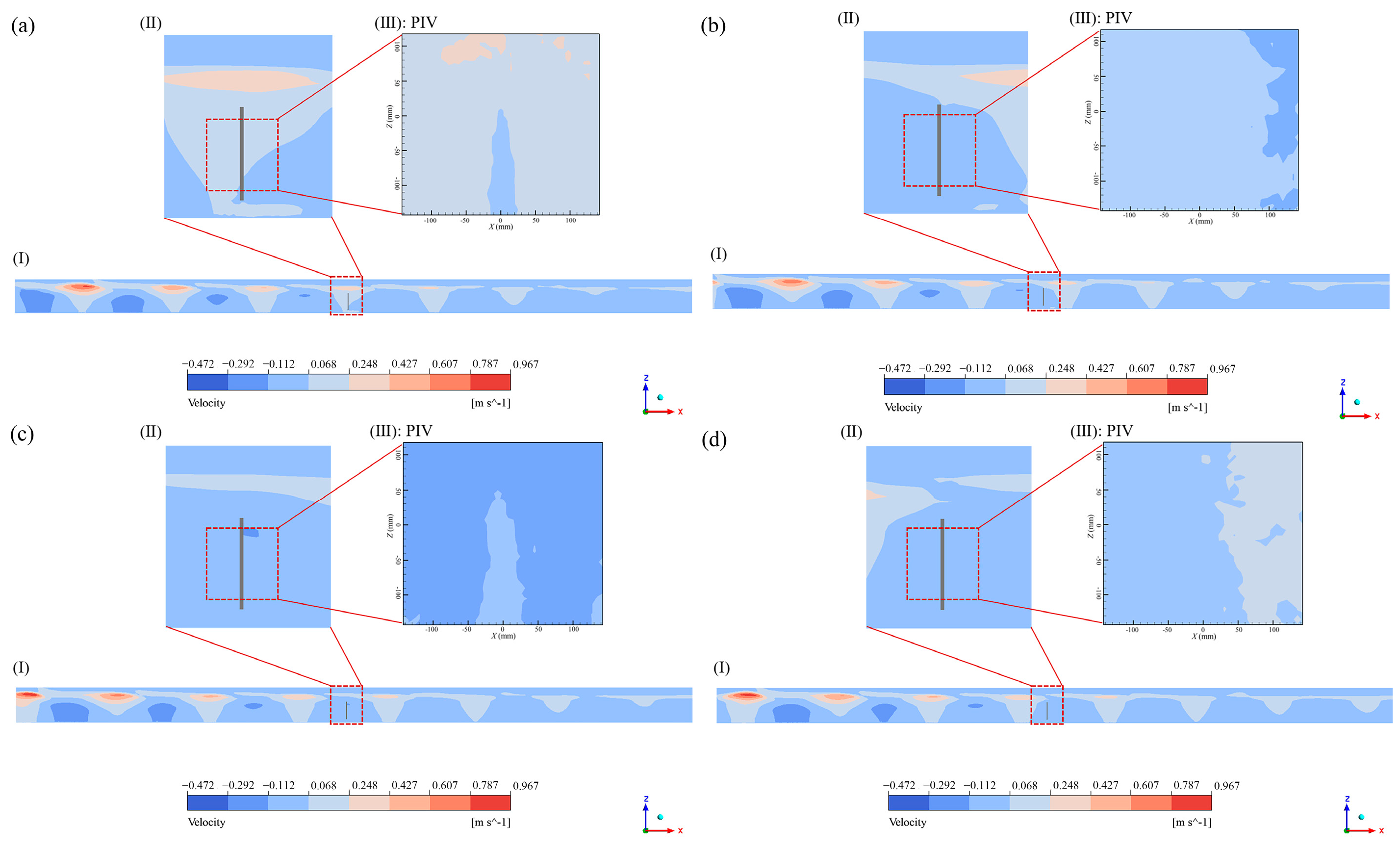

| Netting No. | Materials | Netting Outline Area (m) | Mesh Bar Length l (mm) | Twine Diameter d (mm) | Solidity Ratio Sn |
|---|---|---|---|---|---|
| Net 1 | PA | 0.5 × 0.5 | 0.505 | 0.291 | 0.82 |
| Net 2 | Dyneema | 0.5 × 0.5 | 1.950 | 0.360 | 0.34 |
| Wave Case No. | Wave Period T (s) | Wave Height H (m) | Wave Length L (m) | Wave Steepness H/L |
|---|---|---|---|---|
| 1 | 1.3 | 0.10 | 2.49 | 0.040 |
| 2 | 1.3 | 0.13 | 2.49 | 0.052 |
| 3 | 1.3 | 0.16 | 2.49 | 0.064 |
| 4 | 1.3 | 0.19 | 2.49 | 0.076 |
| 5 | 1.8 | 0.10 | 4.03 | 0.025 |
| 6 | 1.8 | 0.13 | 4.03 | 0.032 |
| 7 | 1.8 | 0.16 | 4.03 | 0.040 |
| 8 | 1.8 | 0.19 | 4.03 | 0.047 |
| 9 | 2.3 | 0.10 | 5.49 | 0.018 |
| 10 | 2.3 | 0.13 | 5.49 | 0.024 |
| 11 | 2.3 | 0.16 | 5.49 | 0.029 |
| 12 | 2.3 | 0.19 | 5.49 | 0.035 |
| Wave Period T (s) | Wave Length L (m) | Net 1 | Net 2 | ||
|---|---|---|---|---|---|
| Dn | Cn | Dn | Cn | ||
| 1.3 | 2.49 | 8,814,758 | 28.16 | 5,848,000 | 19.44 |
| 1.8 | 4.03 | 10,850,000 | 47.79 | 6,476,000 | 22.23 |
| 2.3 | 5.49 | 14,910,000 | 51.18 | 8,328,000 | 23.89 |
| Mesh | Mesh Quality | Maximum Grid Size (mm) | Minimum Grid Size (mm) | Total Elements |
|---|---|---|---|---|
| 1 | Coarse | 50 | 5 | 1,035,819 |
| 2 | Medium | 40 | 5 | 1,265,828 |
| 3 | Fine | 30 | 4 | 2,149,106 |
Disclaimer/Publisher’s Note: The statements, opinions and data contained in all publications are solely those of the individual author(s) and contributor(s) and not of MDPI and/or the editor(s). MDPI and/or the editor(s) disclaim responsibility for any injury to people or property resulting from any ideas, methods, instructions or products referred to in the content. |
© 2025 by the authors. Licensee MDPI, Basel, Switzerland. This article is an open access article distributed under the terms and conditions of the Creative Commons Attribution (CC BY) license (https://creativecommons.org/licenses/by/4.0/).
Share and Cite
Liu, Z.; Hu, F.; Wan, R.; Guo, S.; Wang, Y.; Zhou, C. Regular Wave Effects on the Hydrodynamic Performance of Fine-Mesh Nettings in Sampling Nets. Appl. Sci. 2025, 15, 7229. https://doi.org/10.3390/app15137229
Liu Z, Hu F, Wan R, Guo S, Wang Y, Zhou C. Regular Wave Effects on the Hydrodynamic Performance of Fine-Mesh Nettings in Sampling Nets. Applied Sciences. 2025; 15(13):7229. https://doi.org/10.3390/app15137229
Chicago/Turabian StyleLiu, Zhiqiang, Fuxiang Hu, Rong Wan, Shaojian Guo, Yucheng Wang, and Cheng Zhou. 2025. "Regular Wave Effects on the Hydrodynamic Performance of Fine-Mesh Nettings in Sampling Nets" Applied Sciences 15, no. 13: 7229. https://doi.org/10.3390/app15137229
APA StyleLiu, Z., Hu, F., Wan, R., Guo, S., Wang, Y., & Zhou, C. (2025). Regular Wave Effects on the Hydrodynamic Performance of Fine-Mesh Nettings in Sampling Nets. Applied Sciences, 15(13), 7229. https://doi.org/10.3390/app15137229







